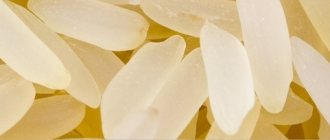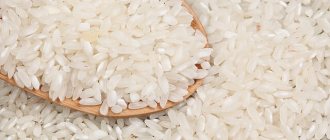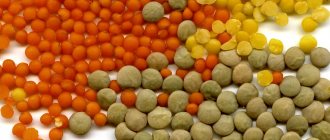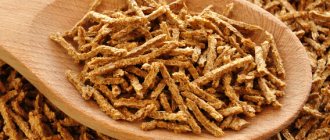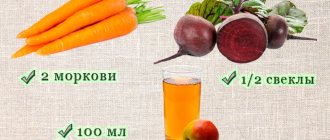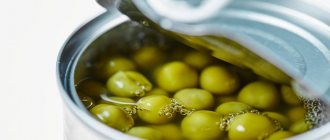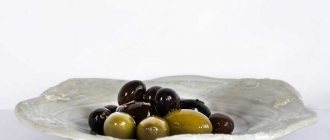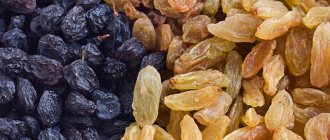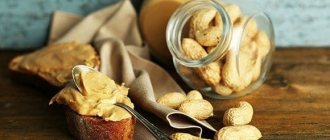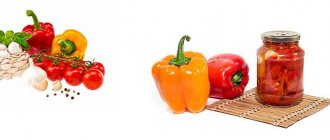Article on the topic
Crispbread is a dietary product. Is it true?
If you want to always stay healthy and slim, stop eating white loaves and rolls made from premium flour and switch to bread products richer in fiber, vitamins and microelements: whole grain loaves, with bran and crispbread. The latter should not be consumed only by children under 2-3 years of age (their young bodies are not yet adapted to such coarse food), but adults can easily make sandwiches from them with low-fat cottage cheese, cheese and vegetables, put low-calorie pates on dry slices and create light ones from them. desserts with fruit. Just don’t think that all bread is equally healthy. There are wonderful crisps made only from whole grains of wheat or corn, and there are examples that do not differ in composition from white bread, and are even supplied with a fair amount of artificial food additives.
What are they made from?
Crispbreads are made from various grains and cereals. The most popular components are the following:
- rye;
- buckwheat;
- oats;
- rice;
- wheat;
- corn;
- linen.
Buckwheat grains are one of the most useful components in the product, due to the rich content of proteins, complex carbohydrates, many minerals and vitamins. Buckwheat bread preserves all the beneficial properties of buckwheat.
When purchasing a product, it is important to study its composition on the label. Healthy breads are made from whole grains. Some manufacturers add biologically active impurities, bran, crushed cereals and plants to the composition of the bread. For gourmets, bread is made with the addition of sesame seeds, pumpkin seeds, sunflower seeds, as well as dried apricots, raisins or prunes. For lovers of salty and piquant taste, products are produced with the addition of seaweed, dill and garlic. Multigrain products are very popular.
What are breads
Traditionally, people believe that bread is a healthy food product. However, not all of them are good for your figure and overall health. Crispbreads are products similar in composition to bread, which replace it on the dietary table. Since this product is new, there are many misconceptions about how to use it correctly. In the usual sense, diet bread is low-calorie. But this is a myth, since they have almost 300 Kcal/100 grams. Breadbreads are valued in dietetics for their composition.
Compound
Dry snacks contain a lot of dietary fiber, fiber, carbohydrates, polyunsaturated and saturated fats, essential and non-essential amino acids. Microelements include phosphorus, magnesium, sodium, calcium, potassium, and iron. The basic composition of the bread depends on the manufacturer and type. They can be made from flour, bran, unrefined grains, corn, buckwheat or pearl barley. Some products contain margarine, malt, starch, yeast, dyes, flavor enhancers and other components that are not very beneficial for weight loss and health.
Chemical composition and calorie content
Crisp bread contains many useful substances:
- carbohydrates;
- unsaturated and polyunsaturated fats;
- amino acids;
- alimentary fiber;
- vitamins.
The energy value per 100 grams of bread is approximately 250 kcal.
The bread contains a huge amount of B vitamins, , , , rich reserves of iron, potassium, magnesium, phosphorus, calcium and sodium, as well as proteins, fats, carbohydrates and fiber. Nutritional value of rye bread (approximately, depending on the brand)
| Nutritional value per 100 grams of product | Quantity |
| Calorie content | 360 kcal |
| Squirrels | 10 g |
| Fats | 4.5 g |
| Carbohydrates | 70 g |
| Cellulose | 18.4 g |
Nutritional value of wheat-oat bread (approximately, depending on the brand)
| Nutritional value per 100 grams of product | Quantity |
| Calorie content | 302 kcal |
| Squirrels | 12 g |
| Fats | 2.5 g |
| Carbohydrates | 58 g |
| Alimentary fiber | 13.5 g |
Nutritional value of dry briquetted wheat-buckwheat bread (approximately, depending on the brand)
| Nutritional value per 100 grams of product | Quantity |
| Calorie content | 290 kcal |
| Squirrels | 10 g |
| Fats | 0 g |
| Carbohydrates | 57 g |
Crisp bread includes carbohydrates, which are broken down in the stomach by enzymes of digestive juices into simple organic compounds and enter the bloodstream.
This allows the body to obtain enough monosaccharides needed for renewed energy without storing excess glucose in the form of fat. Dietary fiber is practically not broken down in the body during its passage through the gastrointestinal tract, but is processed by the intestinal microflora. By absorbing water, fiber increases the volume of waste substances, which allows you to empty your intestines faster. 100 grams of whole grain bread contains 10 grams of dietary fiber. Comparative table of dietary fiber content in products
| Product name (100 g) | Fiber content (g) |
| Bananas | 2,6 |
| Green peas | 6,0 |
| Pears | 3,1 |
| Dried figs | 9,8 |
| Boiled peeled potatoes | 1,8 |
| Buckwheat porridge | 2,7 |
| Oatmeal porridge | 1,9 |
| Wheat porridge | 1,7 |
| Barley porridge | 3,8 |
| Dried apricots | 7,3 |
| Walnut | 6,7 |
| Sweet red pepper | 2,1 |
| Wheat bran | 43 |
| Tomatoes | 1,2 |
| Wheat bread | 0,2 |
| Whole grain bread | 10,0 |
| Green beans | 2,5 |
| Black currant | 2,1 |
| Spinach | 2,2 |
| Apples | 2,4 |
How to choose products
To ensure that the bread product does not disappoint, when purchasing it, you must pay attention to the following:
- Manufacturing method. The “appearance” of whole grain extruded bread is not very attractive: they look rough, uneven, and grains and fibers are clearly visible at the break. If the product is neat, even, absolutely smooth, then it is better to put it aside, provided that the goal is to purchase the most useful product.
- Compound. You need to study the packaging: there should be a minimum of ingredients: grain, wholemeal flour, water, salt. Possible additives: bran, malt, natural fillers. There should be no yeast, fat, or chemical ingredients.
- Appearance. Good bread will be neither soft nor overly hard; it breaks easily, but does not crumble at any touch. You should make sure that there are no suspicious spots on the surface of the product that indicate damage to the product or that the storage conditions were not met.
It is important to pay attention to the integrity of the packaging and expiration date. For many buyers, the main criterion is the manufacturer. Today, products from Baker House are in particular demand.
Types and manufacturing process
Today there are a large number of manufacturers offering various types of bread. Whole grain breads, made from whole grains, are made using the extrusion process. The essence of this method is as follows:
- A mixture of grains is selected;
- Soak the grains for 30 minutes, soak corn grains for 12 hours to soften the outer shell;
- The beans are placed in an extruder for eight seconds under high pressure and at a temperature of 300 degrees Celsius;
- The grains quickly heat up, swell and harden.
An extruder is special equipment that is used to soften grain and give the product the required pressed shape.
Thus, under high pressure in the extruder, water evaporates from the grains, which instantly twist outward. In appearance, they resemble popcorn, only pressed. This product is one of the most beneficial for the human body, since it contains cereals without additional processing or chemical additives. Extruded bread is very popular in European countries due to its ideal composition and large amount of useful substances.
Another type of bread is baked goods in the form of thin crackers or chips. They consist of whole grains and other healthy additives. According to their recipe, they are made in the same way as regular bread. Ground and whole grains are mixed with water, yeast, spices and bran. These ingredients are used to knead the dough, let it sit, roll out into thin layers and bake in the oven. The result is thin, crispy bread.
It is worth noting that in the old days, even leavened bread was prepared in the villages of Siberia.
To do this, they took rye flour and poured boiling water over it, added rye malt, mixed it in an earthenware bowl and placed it in the oven for a day. The resulting dough was formed into small flat cakes in the shape of koloboks and baked in the oven. The resulting flat cakes were crushed and kvass was made from them. Some dried such bread and ate it as a separate dish. Dried cakes could be stored for up to a year.
Diet on bread and kefir
There are a huge number of dietary diets in which the intake of bread is indicated. When losing weight, it is better to choose low-calorie products: oatmeal, buckwheat, rice, bran. The most effective way to lose weight is considered to be a diet based on bread and kefir. This is an ideal combination of products that contain a large list of useful substances. Kefir is known to gently simulate the intestines, having a laxative effect, and coarse fiber cleanses its walls. The classic version of this diet is not strict, but consists of following a couple of recommendations:
- sugar and flour are excluded from the diet;
- you need to eat at the same time 5 times a day;
- 30 minutes before meals you need to eat 2 snacks and drink a glass of kefir;
- In the evening, the portion should be halved.
Fasting day on bread
Even one day a week of fasting will help you achieve amazing results over time. A fasting day on bread and kefir is one of the most effective. Its menu includes 2 packs of dry snacks (about 200 g) and 1 liter of low-fat kefir. The specified volume of products is divided into 5 doses. Be sure to add drinking water - at least 1.5 liters. By arranging such an unloading, it is easy to lose 1-1.5 kilograms per day.
Beneficial features
The benefit of bread lies in its saturation with proteins, carbohydrates, vitamins, minerals and ballast fibers. They may not look as appetizing as fluffy buns and other delicious pastries, but they are undoubtedly beneficial for the body. The calorie content of this product is not much lower than regular bread. Due to the content of proteins, fats, and carbohydrates in the product, the body is filled with strength and energy, and thanks to fiber, the body is naturally cleansed. For those involved in fitness, the easily digestible protein in the product is especially valuable.
The crispbreads do not contain sugar, so they are recommended to be consumed by people who have difficulties with the gastrointestinal tract, who are prone to allergies, as well as those who want to lose weight, and children over four years old.
Fiber plays a significant role in cleansing the body. It is she who is able to absorb and remove toxic substances and carcinogens from the intestines. Insufficient fiber intake can lead to cholelithiasis, atherosclerosis, diabetes mellitus and other diseases. For a modern person, it is enough to consume 25 grams of fiber per day. To meet the daily requirement of coarse fiber for the body, you need to eat about 150 grams of dry products. For comparison, the same amount of fiber is found in 6 loaves of rye bread, 1 kilogram of oatmeal, 3 kilograms of potatoes or 2.5 kilograms of white cabbage. Moreover, white flour bread contains very little fiber.
Rye bread is one of the least high-calorie types. They perfectly remove toxic substances and excess salt from the body, and also improve overall tone. Rye bread contains phosphorus, magnesium, iron and a number of vitamins.
Buckwheat bread helps lower blood pressure, improves atherosclerosis, anemia and coronary heart disease. Due to their high content of folic acid, they are very useful during pregnancy. They strengthen blood vessels, reduce cholesterol in the blood, increase potency and remove radionuclides from the body. Stabilize metabolism and stimulate hematopoiesis. They have a low glycemic index, so they can replace bread in the diet of diabetics. Buckwheat bread contains zinc, iron, copper and B vitamins.
Barley products actively remove radionuclides and nitrates that enter the body along with vegetables and fruits treated with chemicals. Wheat products improve metabolism in the body. They contain sodium, phosphorus, potassium and vitamins.
Rice cakes absorb harmful toxins and saturated fatty acids in the body. They have a good effect on the general condition of the skin, normalize sleep and relieve bad breath. When cleansing the body, it is best to use rice and rice cakes.
Oatmeal bread is recommended for diabetes and problems with the functioning of the heart muscle and nervous system. They stimulate the functioning of the kidneys and liver, and also lead to normalization of heart rate.
Use during pregnancy
If we are talking about high-quality products that have a natural composition, without yeast, margarine and synthetic additives, its use for pregnant women is allowed.
The best option is sprouted wheat bread with bran, which contains:
- Coarse plant fibers that will cleanse the intestines and prevent constipation, the risk of which increases several times during pregnancy.
- A vitamin complex and microelements necessary for the expectant mother, which will support the functioning of the heart, kidneys and liver, which experience a double load during pregnancy, normalize hemoglobin levels, accelerate metabolic processes and create the best conditions for the baby’s growth and development.
- Slow carbohydrates, which provide the body with energy for a long period, prevent overeating and the appearance of fat deposits, which helps a woman maintain a slim figure.
- Amino acids that maintain muscle elasticity and prevent the appearance of stretch marks on the abdomen and chest.
The expectant mother needs to remember that if she loves bread too much, its high calorie content and large amount of coarse fiber can negatively affect her body. You should adhere to a reasonable rate of consumption of bread breads and be sure to combine them with other products, since only in this case they will be beneficial.
Contraindications and harm
Despite many useful properties, bread has certain contraindications. It is highly not recommended for children under four years of age to consume this product. This is due to the fact that due to the high fiber content of the breads, they can overload the delicate digestive system of the child’s body. Also, bread can be harmful to those who have a persistent intolerance to gluten, which grains are rich in. This can lead to intestinal irritation. The exception is buckwheat bread, which is gluten-free. Bread is also harmful for those who suffer from diarrhea.
Some manufacturers may add various antioxidants and preservatives to bread rolls to extend their shelf life. Therefore, before purchasing, be sure to read the contents indicated on the product label. For an ideally healthy product, whole grains must be included in the composition of the bread. It is important that the product does not contain modified starch, dyes, preservatives or antioxidants.
When choosing a product, it is important to pay attention to the packaging. It should not be torn or defective. Be sure to look at the expiration date on the packaging. Briquettes last the longest – up to 1.5 years. Baked cereal shortcakes are stored for 6 to 10 months.
Characteristics of ideal bread:
- uniform in color, baked, dry and crispy;
- without artificial additives, modified starch, dyes, preservatives and antioxidants.
Having unwrapped the packaging, before eating the product, you need to pay attention to how it looks externally. Bread should be brittle and crispy, and baked products should have a well-baked crust and a rough surface.
Natural briquettes and “false bread”
Which breads are most useful for weight loss? You need to understand that all of the above beneficial properties of bread are inherent specifically in extrusion products. And they help normalize weight and saturate the body with health. They are easy to identify by appearance: round and curvy.
There are also some good thin snacks that are baked. But they do this from coarse whole grain or peeled flour, enriching the product with flax, sesame or sunflower seeds. They are also quite suitable for dietary nutrition. These snacks look like flat, oblong crackers.
But don't get confused. Sometimes manufacturers prepare snacks using a regular bread recipe. Then they cut into slices, thin them and proudly indicate on the packaging that this is bread. But other than the name, such products have nothing in common with real bread.
Study the composition carefully. If yeast, sugar, dyes, salt, fats and preservatives were used in production, such a product has nothing to do with the dietary menu. And in this case, it would be more correct and cheaper to eat a piece of low-calorie Borodinsky.
Recommendations for use
Best materials of the month
- Coronaviruses: SARS-CoV-2 (COVID-19)
- Antibiotics for the prevention and treatment of COVID-19: how effective are they?
- The most common "office" diseases
- Does vodka kill coronavirus?
- How to stay alive on our roads?
This product is appreciated by people who watch their diet and are supporters of a healthy lifestyle. Crisps promote weight loss due to their lower glycemic index.
Bread has a high glycemic index, which provokes a rapid release of insulin into the blood. Crisps are digested with low levels of insulin without sudden spikes in sugar. The pancreas functions at a normal pace, gradually releasing portions of insulin into the blood. Thus, the feeling of hunger quickly passes.
For effective nutrition, nutritionists recommend consuming no more than five slices per day. It is best to combine them with vegetables, butter and sour cream, as well as nuts, eggs and legumes. Due to the fact that the bread saturates the body with energy for four hours, it is not recommended to eat it before bed.
It is best to store products in a dry and cool place where there is no moisture.
You can buy bread rolls at any grocery store. Dr.Korner breads are considered the most popular among fans of healthy eating. They are an excellent alternative to bread.
Product varieties
All the variety of modern bread can be classified according to the method of production and composition. According to the first criterion, the following products are distinguished:
- Extruded. They are considered the best, since only whole, unrefined grains are used for their production. The process for making extruded whole grain products is similar to the process for making popcorn: the kernels explode from the inside under the influence of hot steam. But here there is high pressure, which compresses the grains, sticks them together and presses them, creating delicious bread. For large grains with rough, thick skins, pre-soaking is performed, the purpose of which is to slightly soften the dense shell tissue.
- Baked from wholemeal flour with the addition of water. The resulting dough is rolled out into a thin layer and baked like a flatbread. Fillers are sometimes added to the dough - raisins, dried apricots, nuts or seeds. The value of such breads is somewhat lower than whole grain breads, but the presence of fillers is their undoubted advantage.
- Bread made from premium flour. In terms of quality they are in last place. They are based on yeast and margarine with the addition of sugar, salt and other spices. In essence, this is the same bread, only dried and shaped like a flat cake.
Recipes
Crispbread can be prepared at home.
Flax bread
Ingredients:
- flax seeds – 300 grams;
- carrots – 600 grams;
- water – 0.45 liters;
- salt – 2 teaspoons;
- black pepper - to taste
- coriander – 1 teaspoon;
- adjika – 1 teaspoon;
- garlic – 5 grams;
- onion – 30 grams.
Cooking principle:
- Grind flax seeds.
- Chop carrots and onions.
- Combine all ingredients using a blender.
- Distribute into pieces and place in the oven for 90-120 minutes at a temperature of 50-80 degrees Celsius.
How to cook it yourself
If you don’t trust store-bought products, but want to be firmly confident in the quality of the bread, you can bake them yourself at home, at the same time experiment and choose a combination of different types of flour, improve the taste of the product with the help of various additives, combining the bread with different products.
Basic manufacturing principle:
- You need to mix wholemeal flour, salt, and other ingredients with purified water and knead into a stiff dough.
- Roll out the cake to a thickness of several millimeters.
- Form the loaves using a glass and a cutter, cutting into squares or diamond shapes with a knife.
- Crispbread can be cooked in a double boiler, oven (temperature 230-250 °C) and even in a frying pan, after greasing it with vegetable oil.
As a topping you can use cheese, feta cheese, cottage cheese, any vegetables, herbs. The finished bread should be placed on a wide plate and served with the first and second courses instead of regular bread.
At what age can bread be given to children?
Despite the fact that the benefits of bread for the body are great and their harm is small, experts recommend giving snacks to children after three years of age. In this case, the daily norm should include no more than 2 - 3 pieces. The product contains coarse fibers that are difficult for a fragile child's stomach to digest, which is why it is strictly forbidden to give the product to very young children: they can lead to stool problems, bloating, and pain in the stomach.
Before introducing bread into your diet, you need to check if your child is allergic to them. You should give your baby a small piece of the briquette and monitor his reaction throughout the day. If no changes are observed, you can give the product, but in small quantities.
Attention! If any symptoms indicating an allergy appear, your baby should stop eating bread and consult a doctor.


